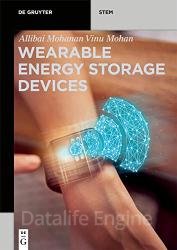 Название: Wearable Energy Storage Devices
Название: Wearable Energy Storage DevicesАвтор: Allibai Mohanan Vinu Mohan
Издательство: De Gruyter
Год: 2021
Страниц: 144
Язык: английский
Формат: pdf (true), epub
Размер: 10.1 MB
Flexible and stretchable energy storage devices are increasingly being needed for a wide variety of applications such as wearable electronics, electronic papers, electronic skins, smart clothes, bendable smart phones and implantable medical devices. Wearable Energy Storage Devices discusses flexible and stretchable supercapacitors and batteries, stretchable and self-healing gel electrolytes, and hybrid wearable energy storage-harvesting devices.
The advent of internet of things is accompanied by tremendous developments in the field of flexible electronics, particularly, biointegrated wearable devices, implantable biomedical devices, electronic skin, roll-up displays, and intelligent mobile devices. These innovative flexible devices could be effortlessly merged with our routine life, and are useful for diverse advanced applications like personalized healthcare monitoring and therapy, auto responsive drug delivery, fitness oriented activity monitoring and feedback analysis, motion monitoring, and interactive rehabilitation. The medical diagnostic tools are being focused on noninvasive monitoring of healthcare markers near the patient site, in the home environment. Such biointegrated self-controlled devices are suitable for routinely monitoring the physiological condition, early detection, and ensuring timely medical attention. The advent of smart wearable technologies facilitates mapping of the complete human health via integrative medicine. The wearable physical sensors monitor various physiological parameters such as heart rate, blood pressure, respiratory rate, oxygen saturation, temperature, and accidental falling. The sensors can be controlled by an integrated miniaturized microprocessor that wirelessly transmits the collected quantitative/qualitative health metrics to the smartphone or other wearable gadgets.
The continuous usage of wearable devices for diverse applications, including data collection and transmission facilities, requires abundant energy over an extended period of time. Hence, it is necessary to integrate the wearable electronics with energy storage devices having high energy densities. In the last few years, the electrochemical energy storage systems have made tremendous progress, particularly, lithium-ion batteries (LIBs) and supercapacitors. The major applications of these devices range from low-power implantable devices to portable apparatus to electrical vehicles to grid-scale power management systems. The major developments in the existing energy storage devices are focused on the rigid and bulky prototypes, and their assimilation with the bendable gadgets is challenging. The merging of rigid and bulky energy storage devices along with the bendable electronics is cumbersome and that limits the facile integration with the skin or textile substrates. The forcible assimilation of rigid devices into the non-planar surfaces causes device damage and low performance. Thus, the next-generation energy storage devices are targeted to realize shape conformable and mechanically resilient so as to withstand the external stress that arises from the irregular body movements during normal or exercise activities. An ideal flexible electronics exhibit extraordinary bendability, stretchability, foldability, twistability, and should possess stable performances during mechanical deformations. Ideally, the mechanical properties of the devices need to be similar to that of the wearable substrates. The following sections describe the mechanical properties of the bendable and stretchable materials and other structural configurations to yield stretchability. The mechanics of various structures and their relation with the physical nature and properties of the device components are detailed.
Batteries are one of the most suitable candidates for powering flexible electronic devices owing to their high energy and power density, and cycle life. In comparison to batteries, supercapacitors possess high power density and moderate energy density. As the wearable devices mandate flexible and stretchable power sources, it is important to develop fully flexible batteries and supercapacitors with all soft and stretchable constituents. The major components of these devices include current collectors, active electrodes, electrolytes, separator and the outer laminating/package materials. The mechanical properties of all these device components should be similar and any mismatch causes detaching of active materials from the current collector, gel detachment, poor electrical conductivity, and ionic conductivity. The increase in internal resistance of the system results in large ohmic drop and abysmal energy storage activities. In addition, the delaminated electroactive components may penetrate through the separator and which can increase the risk of electrical short circuit. Hence, ideal wearable energy storage devices should consist of equally deformable soft constituents, and must withstand severe mechanical distortions and maintain the charge-discharge activities.
Contents:
Abbreviations
1 An overview of wearable energy storage devices
1.1 Introduction
1.2 Flexible and stretchable energy storage devices
1.3 Bending mechanics of energy storage devices
1.4 Mechanics of stretchable energy storage devices
1.5 Summary
2 Flexible and stretchable supercapacitors
3 Flexible and stretchable batteries
4 Stretchable and self-healing gel electrolytes
5 Hybrid wearable energy storage–harvesting devices
References
Index
Скачать Wearable Energy Storage Devices
[related-news] [/related-news]
Комментарии 0
Комментариев пока нет. Стань первым!















